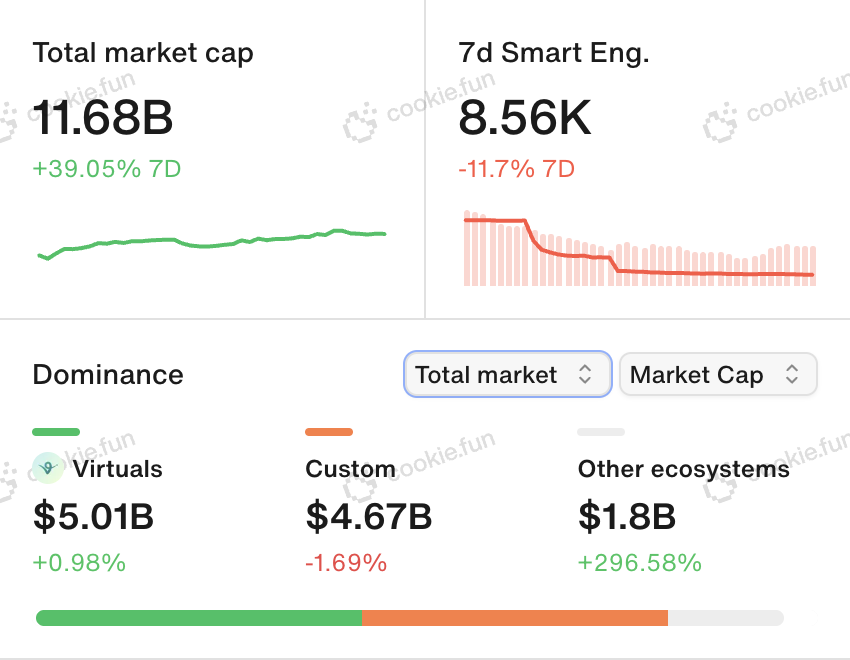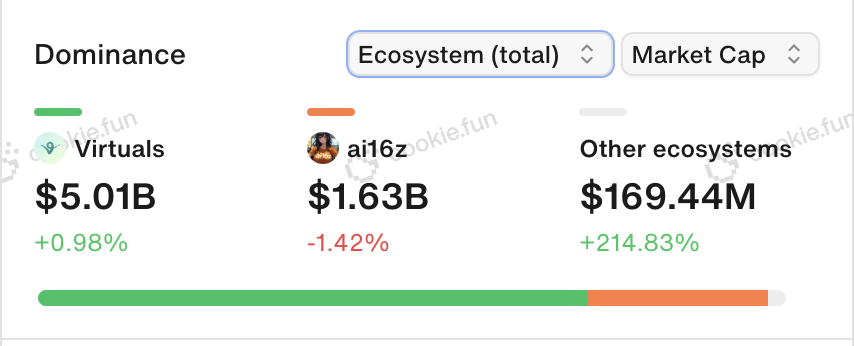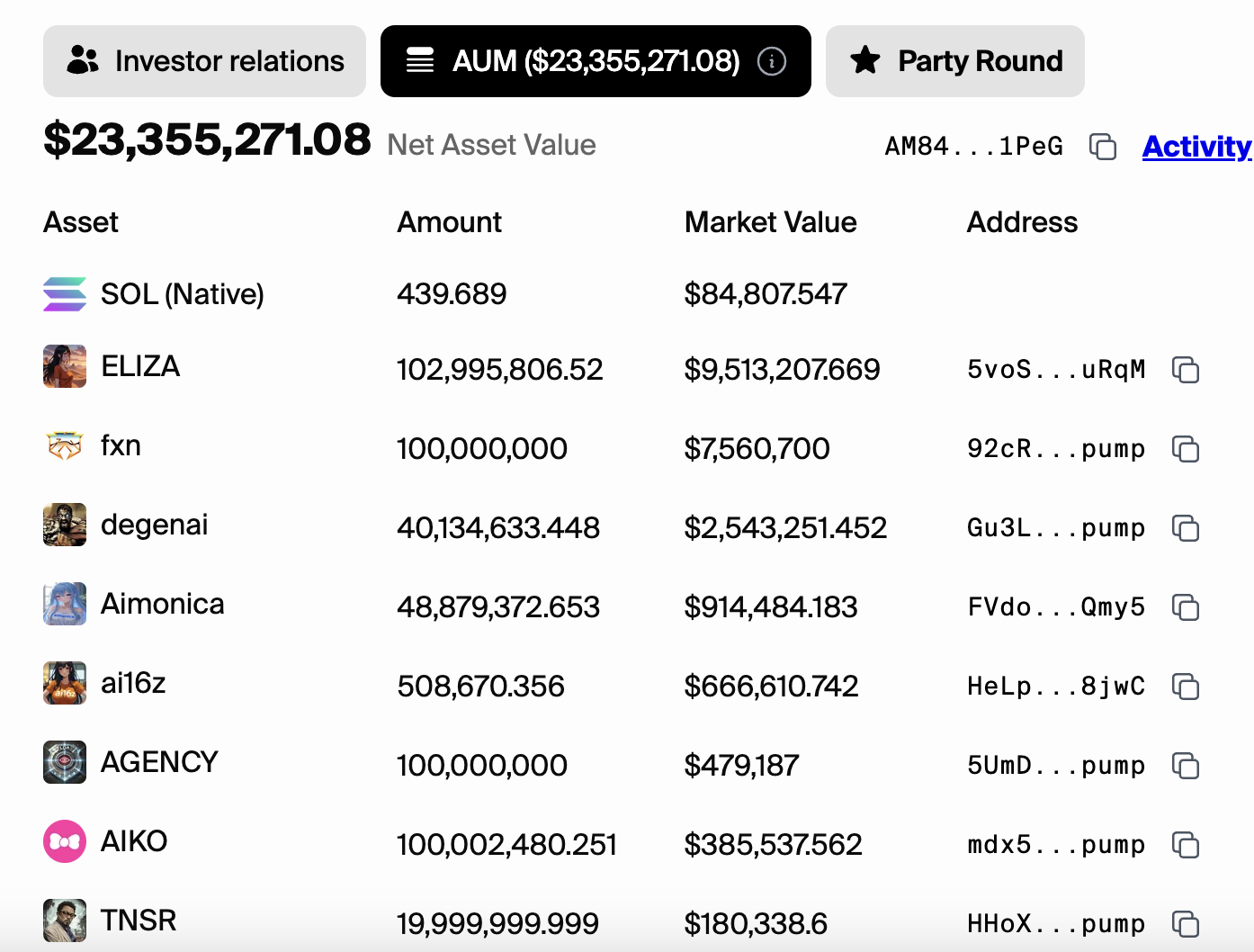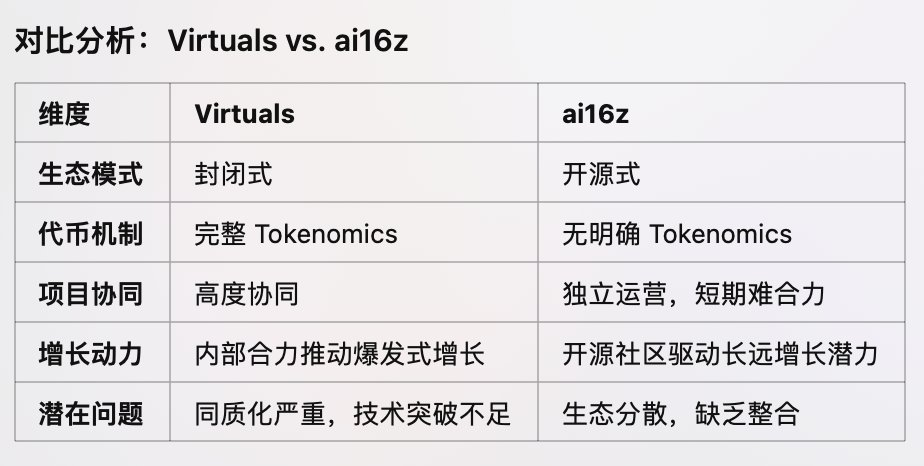Author: Nancy, PANews
With the improvement of infrastructure and the gradual implementation of application scenarios, the crypto AI Agent ecosystem is becoming more prosperous, presenting a new market development trajectory, and liquidity and user participation are also rising. In this AI Agent craze, ai16z and Virtuals Protocol are undoubtedly the two most powerful representative projects, and their ecosystems have attracted various capitals to actively dig for gold.
ai16z and Virtuals dominate the AI Agent market, contributing more than half of the market share
Although the AI Agent ecosystem has risen rapidly in the crypto market and attracted a lot of attention and capital, its market structure is still relatively simple and mainly relies on the promotion of a few leading projects.
According to the latest data from Cookie.fun, as of December 30, the overall market value of AI Agent has reached 11.68 billion US dollars, with an increase of nearly 39.1% in the past 7 days. This growth trend shows the rapid growth of the AI Agent ecosystem in the crypto market.

From the perspective of ecological scale, the entire encrypted AI Agent has an obvious head effect, mainly dominated by two projects, Virtuals and ai16z. Specifically, the ecological market value of Virtuals reached 5.01 billion US dollars, and ai16z was 1.63 billion US dollars, and the two accounted for 56.8% of the AI Agent market share. This also means that the current growth and development of AI Agents depends more on the construction of these two leading projects.
At the same time, in terms of type, the market value of Virtuals exceeds that of customized AI Agent, which is US$4.67 billion, and the cumulative market value of other categories reaches US$1.8 billion.

From the perspective of on-chain distribution, Base and Solana are the two major battlefields of AI Agent. Among them, the market value of AI Agent on Base is about 5.76 billion US dollars, and the market value on Solana is 5.47 billion US dollars. The two together contribute 96.1% of the overall market. The market value of other on-chain projects is only 920 million US dollars, which further shows that the AI Agent ecosystem is still in its infancy.
Although Base and Solana are comparable in terms of the market size of AI Agent, their ecosystems are significantly different. The main project of the Base ecosystem is Virtuals, and 86.9% of the projects come from this ecosystem. In contrast, ai16z only occupies nearly one-third of the market share on Solana, which shows that the AI Agent ecosystem on Solana is richer and more diverse than that on Base.
Different ecological development paths are presented , but the market concentration is obvious
With the popularity of Virtuals and ai16z, their ecological projects have also become the focus of attention and bets of market investors.

According to daos.fun data, as of December 30, ai16z's net asset value (NAV) was approximately $23.355 million, covering more than 1,400 tokens. Among these tokens, there are only three tokens with a market value of over one million US dollars, namely ELIZA, fxn and degenai, and the cumulative market value of the three accounts for 84.3% of the total; there are six tokens with asset sizes between $100,000 and $1 million, and the market value of the remaining tokens is less than $100,000. This distribution shows that ai16z's token portfolio is relatively centralized, with a few high-value tokens dominating the overall asset size, while the market value of most tokens is relatively dispersed, showing that the ecosystem is still in a highly differentiated state.
Compared with ai16z, the quality of Virtuals ecosystem projects is relatively high, and it has recently been hotly discussed because its market value exceeds that of the star AI project Bittensor (TAO). Despite this, there is also a certain structural imbalance in the Virtuals ecosystem.
The Virtuals official website shows that as of December 30, there are about 510 Virtuals ecological projects. Among them, there are 4 projects with a market value of more than 100 million, namely AIXBT, GAME, Luna and VaderAI , accounting for 19.2% of the overall ecology; there are 99 projects with a market value between 1 million and 100 million US dollars, and the remaining 60% of the projects have a market value of less than 100,000 US dollars. The overall Virtuals ecological projects have gained more market recognition, but there are certain concentration problems in its ecological development.
Regarding the different AI Agent development routes of ai16z and Virtuals, Haotian , an independent researcher at Web3, previously pointed out in an article that ai16z is relatively open source and more like an "Android-style" developer ecosystem alliance route, but because the ai16z token is at the extreme of tokenless economics, its family bucket tokens lack a reasonable evaluation model and cannot form a joint force in the short term. However, all this will be solved after a systematic Tokenomics. At the same time, each member of the ai16z family bucket has its own magical powers, and the stamina lies in the power of the developer community. The first thing founder Shaw has to do is to lead the scattered family bucket onto a super open source growth flywheel driven by the technical open source community.
In a recent interview with PANews , Shaw revealed that ai16z will announce a new token economics proposal around January 1, 2025, including LP matching mechanism, DeFi function integration and other contents.

Comparison between Virtuals and ai16z, source: @0xgangWhat
In contrast, Virtuals is relatively closed. Haotian pointed out that Virtuals has taken an "Apple-style" ecological expansion route, more like an AI Agent "star-making dream factory". Since Virtuals had a complete token economics in the early days, users need to pledge VIRTUAL tokens to create AI Agents, and users need to consume VIRTUAL tokens to purchase new AI Agent tokens. Therefore, the more AI Agents are issued on Virtuals, the greater the demand for Virtuals tokens, and the positive growth flywheel effect will naturally occur. However, since Virtuals focuses on asset issuance platforms and provides a standard AI Agent framework base, the AI Agents on the platform will be more homogenized. Virtuals, which focuses on asset issuance but not technical ecological breakthroughs, is essentially the inherent limitation of a closed ecosystem.
From pure MEME to on-chain applications, AI Agent innovates market operation mode
Behind the hype about Virtuals and ai16z is the increased attention paid to AI Agents, which is also an important manifestation of the development and evolution of MEME.
"AI is the biggest theme for the improvement of human technology and productivity in the next 20 years. It can be integrated into all Crypto categories, including DeFi, GameFi, NFT and Desci. During the period of rapid improvement, it will bring a large number of new applications and new technologies, which can all be applied in Crypto." Crypto KOL 0xWizard believes that new targets combined with AI may recreate the market value of on-chain assets and even the total market value of crypto.
"From the initial pure MEME like GOAT, to the AI Agent that can chat, to the on-chain fund like ai16z, and then to the new asset issuance platforms like Virtual and Spore, each step is getting closer and closer to application. The essence of this round of on-chain market is that new "application projects" bypass exchanges and VCs and directly realize the redistribution of benefits through the model of issuing new assets on the chain. At the same time, project parties do not need to lick VCs, compete for resources, and find exchanges to pay tolls. They can be directly pulled out on the chain to "take a walk" to see if the market will buy it." Crypto KOL @Michael_Liu93 pointed out.
Haotian also believes that the environment has changed, and the logic of market value capture is also changing, which is mainly reflected in the following points: (1) From the previous infrastructure stacking that was out of touch with the actual market demand to the use of AI Agent applications to verify market demand; (2) In the past, VC rounds of financing have led to increasingly narrow profit margins in the secondary market. Now, projects built in the form of open source Public Good can directly face secondary market financing, and allowing AI Agents to manage assets independently can bring greater imagination space to projects; (3) In the past, airdrops to obtain early users and traffic brought subsequent operational pressure. Opening the market in a MEME-based secondary way is suitable for the continued growth of Tokenomics (LP handling fees, transaction taxes, reserved share release, etc.); (4) After breaking the final stage of CEX listing, it will gradually tend to be dominated by DEX, and high-quality projects have a greater probability of "grassroots counterattack"; (5) To achieve new market operation rules, it is basically difficult for projects that do not integrate with the community and do not always focus on the product to emerge in the market and ecology.














